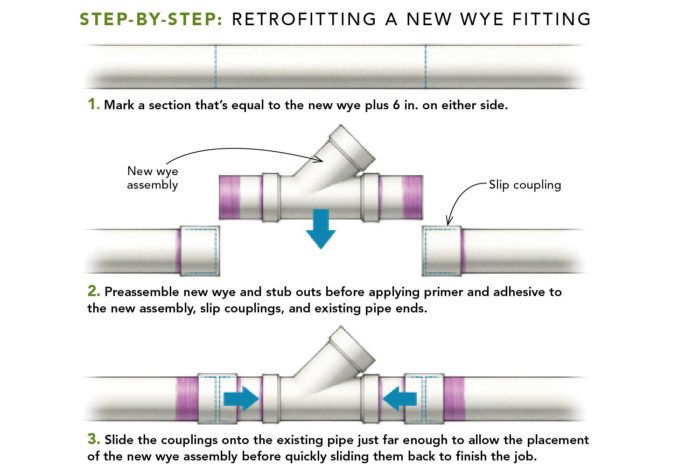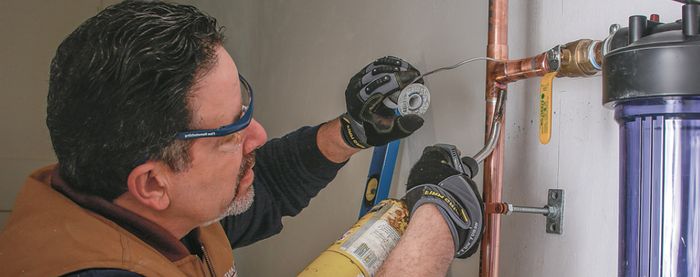Tying Into an Existing Drain Line
Rubber couplings are a popular code-approved option, but plumber Tom Cardillo prefers the added stiffness and durability of a permanent connection whenever possible.

I’m roughing in the drain-waste-vent (DWV) plumbing for a new second-floor bathroom in my house. I used solvent-weld fittings for the DWV lines in the bathroom floor, and was planning to do the same when tying into the 4-in.-diameter PVC waste line that runs along (and out) my basement wall. But because the drain line is locked into place, I realized I can’t just cut out a section, slide in a glued fitting, and pull the two halves together again. Is a rubber fitting the best bet to solve this problem?
—Jay, via email
Plumber Tom Cardillo: Tying into an existing drain line that has no wiggle room can be tricky. Solvent-weld fittings are meant to slide over the outside of a pipe, which you can’t do if the pipe is fixed in place. In these cases, I rely on solvent-weld slip couplings. Rubber couplings are a popular code-approved option, but I prefer the added stiffness and durability of a permanent connection whenever I can get it, and consider the rubber options to be a last resort. But whether using plastic or rubber couplings, the first part of the sequence is the same.
Before cutting into the existing pipe, it’s best to take precautions to ensure that absolutely no water is in the pipe. It only takes a small amount of water to spoil a joint that’s being glued. I always like to shut the water main for the whole house to be sure.
Mark and cut a section out of the existing drain line that’s 12 in. longer than the wye fitting you want to install. Either a reciprocating saw with a fine-tooth blade or handsaw made for cutting PVC will work. I prefer the handsaw because there’s less shaking and vibration, and accuracy is far better when you can watch each saw stroke.
After cutting, let any residual water drip out. While you’re waiting, cut two pieces of new PVC pipe to approximately 7-1/2 in. each, which will leave enough pipe to slide into the socket of both the wye and the coupling. Dry-fit the new wye assembly and test-fit it in the open section that you cut out of the drain line. (Note: when tapping into a horizontal drain, always use a wye fitting, never a tee wye). You want 1⁄4-in. gaps on either side—just enough to insert the piece and slide the fittings into place. If the gap is too wide, just cut a longer piece for one side of the wye and recheck.
When you’ve confirmed it will fit properly, prime one end of each pipe piece and both mating sockets of the wye fitting before immediately applying cement to the same areas. Push the pieces into each side of the wye and give them a quarter-turn twist.
Here’s where it gets tricky—you need to prep and manage multiple glued connections in a matter of seconds. You must prime the couplings, the pipe ends of the existing drain, and the pipe ends of the new wye assembly you just made. Then apply a generous amount of glue to the same areas. As fast as possible, slip a coupling on each end of existing drain pipe, pushing each coupling up far enough to allow the new wye assembly to fit into place. Once in position, slide the couplings back down onto the wye assembly so the center of each coupling is over the 1/4-in. gap you left, again adding a quarter-turn twist. The new drain line can be tied into the remaining opening in the wye, and you should be in business.






View Comments
I know that I am not a professional plumber, but I have done enough with pvc pipe I know that I would not attempt an all glued solution with out three people, each with their own primer and glue. One to prime, glue and handle each coupling and one to position the wye assembly. If I attempted it by myself, I know the results would be;
Step 1) as directed above;
Step 2) cut out new couplings that seized before they were placed in the correct positions and the incorrectly aligned wye assembly;
Step 3) make a new, longer wye assembly to fit the larger gap in the original pipe and assemble with rubber couplings that will allow me as long as necessary to properly align everything.
I think I'd put the slip couplings on the existing line, pull them several inches back from the joints and mark the existing pipe for the final position of outboard ends of the couplings. Then I'd slide one coupling over the existing line and the new wye assembly (dry fit), in order to support the wye assembly. Then I'd apply glue to the area occupied by the coupling on each side of the other joint, both the running line and the wye assembly and then quickly move the slip coupling over the joint, using the marking for positioning. Then I'd do the same with the other joint. Cardillo's text indicates he's comfortable with sliding the slip couplings into place before the glue sets.